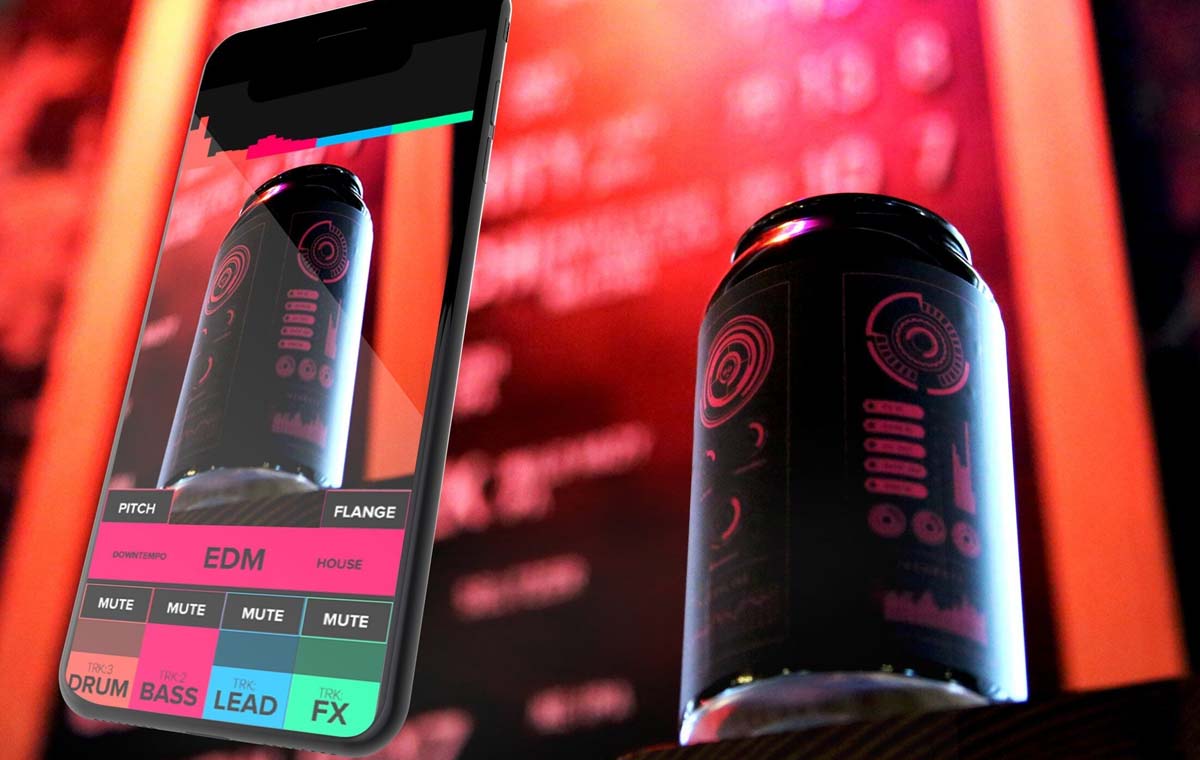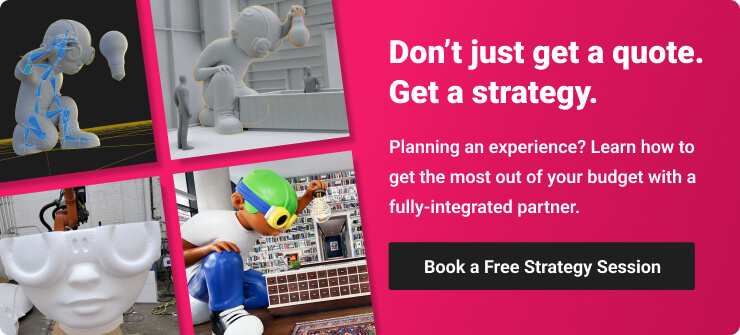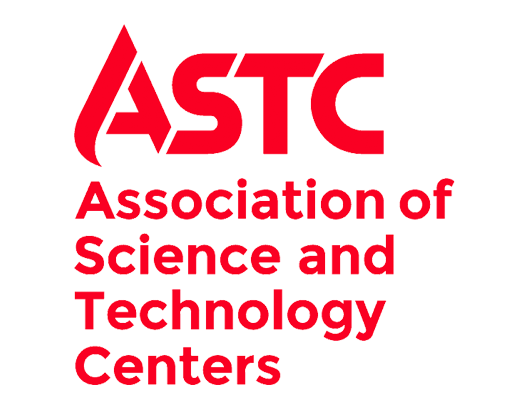In a world where digital experiences are ubiquitous, experiential technology has emerged as a game-changer for brands and institutions looking to level up their environments for in-person experiences.
Imagine walking through a museum where the exhibits come to life, or utilizing a holographic kiosk for personalized product recommendations at your favorite store. These aren't future fantasies—they are possible today thanks to the rapid advancements in experiential technology. These tools not only bridge the gap between the digital and physical worlds but also create immersive experiences that leave lasting impressions.
Plus, experiential technology isn't just about the wow factor—it's also a powerful tool for driving business results. But how exactly does this technology work, and why is it so effective in creating these captivating experiences? As we delve deeper into the mechanisms and benefits of experiential technology, you'll discover why it's more than just a trend and how it can be a cornerstone for audience engagement.
What is Experiential Technology?
At its core, experiential technology encompasses anything that uses digital tools to transform an environment and create a memorable experience. It's the magic behind interactive museum exhibits, immersive retail spaces, and captivating brand activations. But what exactly does it include?
Experiential technology is a broad term that covers a wide range of hardware and software. It includes everything from projection mapping and LED walls to motion sensors and haptic feedback devices. Essentially, it's any technology that can be used to create an immersive, interactive experience.
Think of it this way: if traditional technology is about conveying information, experiential technology is about creating a feeling. It's about taking people out of their everyday surroundings and plunging them into a new environment, bathing them in sound, light, and content to create a truly transformative experience.

Technology as a Storytelling Tool
Here's a crucial point to remember: technology is a digital storytelling tool. It's not about using tech for tech's sake. The most effective experiential technology is often invisible – guests aren't thinking about the tools behind the experience, they're simply immersed in the story being told.
Consider this: when you watch a great film, you're not consciously aware of the camera work or the editing. You're caught up in the narrative, the emotions, the journey. That's what great experiential technology should do. Ultimately, it provides a level of depth to a guest experience that can't be delivered any other way.
For example, imagine walking through a museum exhibit about ancient Egypt. Traditional displays might house artifacts in glass cases with informative plaques. But with experiential technology, you might find yourself standing in a virtual reconstruction of the Great Pyramid, watching as it's built stone by stone around you. You're not just learning about history – you're experiencing it.
This is the power of experiential technology as a storytelling medium. It's a way to convey a narrative that aligns with the goals and objectives of the experience or brand. But it's important to remember that it's just one of many methods to tell a story in an experience. The key is choosing the right tool for the job.
Innovative Examples of Experiential Technology
Let's dive into some of the most exciting forms of experiential technology that are shaping immersive experiences today.

KAP media partnered with Bridgewater Studio to turn three triangle-shaped buildings into larger-than-life Doritos for a recent campaign.
1. Projection Mapping: Transforming Spaces with Light
Have you ever seen a building come alive with moving images that seem to bend and reshape its architecture? That's projection mapping in action. This technology uses specialized software to project visuals onto irregularly shaped surfaces, turning any object or space into a dynamic video display.
Projection mapping isn't just visually stunning – it's incredibly versatile. It can be used to create larger-than-life brand activations, like transforming a triangle-shaped building into a Doritos chip. Or it can transform a commercial interior, like Motorola using projection mapping to create an ever-changing digital carpet in their corporate lobby.
2. Holography & Pepper's Ghost Effects: Bringing 3D Visuals to Life
Remember that scene in Star Wars where Princess Leia appears as a 3D hologram? While intergalactic space travel isn’t a reality yet, modern holographic technology is getting close. Using a technique called Pepper's Ghost, we can create incredibly realistic 3D illusions that seem to float in mid-air.
This technology is finding applications across industries. Imagine a retail store where you can see a 3D hologram of a product, rotating it to view it from all angles before you buy. Or picture a museum where historical figures come to life as holograms, sharing their stories directly with visitors.

3. Haptic Technology: Introducing Tactile to Digital Experiences
Haptic technology adds a sense of touch to digital experiences. It's what makes your phone vibrate when you type, but it's capable of so much more. In experiential design, haptic technology can create a powerful sense of presence and interactivity.
For instance, at the Adler Planetarium's "Big Bang" exhibit, visitors can feel the vibrations of cosmic events through haptic floor panels. At the University of South Carolina’s Football Ops Facility, this fan experience uses haptic feedback to reveal new content when touched, creating an interactive 3D touchscreen effect. These tactile elements help drive engagement, making digital experiences feel more real and immediate.
4. Mixed Reality (MR): Blending the Physical and Digital Worlds
Mixed Reality takes the immersion further by seamlessly blending digital elements with the physical world. Unlike Virtual Reality, which replaces your environment entirely, MR enhances your existing surroundings with digital overlays.
This technology has exciting applications in fields like education and museums. Imagine a historical exhibit where visitors can see and interact with 3D models of historical artifacts. Or consider a museum exhibit where guests can travel through time to experience life in different centuries or across continents.

Multi-Sensory Advancements in Experiential Technology
To create truly immersive experiences, experiential technology often engages multiple senses. Let's explore some key technologies that contribute to multi-sensory experiences.
1. LED Walls: Creating Immersive Visual Landscapes
LED walls are transforming the way we create large-scale visual displays. Unlike traditional projection systems, LED walls offer bright, high-contrast images that deliver consistent performance, even in well-lit environments. They're incredibly versatile, able to create everything from realistic backdrops to abstract, artistic displays.
For example, the University of Michigan Alumni Center uses a massive, curved LED wall to create an ever-changing visual centerpiece that showcases university life and achievements. In the world of real estate, developments like 1000M in Chicago use LED walls in their sales centers to give potential buyers an immersive preview of their future homes.
2. Motion Tracking: Interactive Experiences in Real-Time
Motion sensors allow experiences to react to visitors in real-time, creating a sense of magic and interactivity. These can be used to trigger content based on a visitor's movements, creating personalized, responsive experiences.
In museums, motion sensors might trigger explanations as visitors approach exhibits. In retail environments, they could change product displays based on where a customer is looking. At SoFi Stadium in Los Angeles, motion sensors help provide an authentic ‘run through the tunnel’ experience for NFL fans touring the facility on non-game days. The key is that these interactions feel natural and intuitive, enhancing rather than distracting from the overall experience.
3. Scent Technology: Engaging the Oft-Forgotten Sense
Did you know that scent is one of our most powerful memory triggers? Scent technology in experiential design can create powerful, emotionally resonant experiences. However, it needs to be used carefully and in balance with other elements.
When done right, scent can transport visitors to another place and time. Imagine a museum exhibit about the rainforest that not only looks and sounds like a jungle but smells like tropical flowers and fresh rain. Or consider a brand activation for a coffee company that fills the air with the rich aroma of freshly ground beans.

Leveraging Experiential Technology in Creative Ways
Now that we've explored the tools, let's look at how experiential technology is being used to create unforgettable experiences across different sectors.
Designing Immersive Brand Experiences
Brands are increasingly turning to experiential technology to create memorable activations that go beyond traditional advertising. These experiences allow customers to interact with the brand in a meaningful way, creating emotional connections that drive loyalty.
For instance, a sportswear brand might create a virtual reality experience that lets customers test their products in simulated extreme conditions. Or a beauty brand could use augmented reality mirrors to let customers try on makeup virtually.
Enhancing Museum and Educational Spaces
Museums and educational institutions use experiential technology to breathe new life into their exhibits and curricula. Interactive displays can make complex topics more accessible and engaging, while immersive experiences transport visitors to other times and places.
Imagine a natural history museum where visitors can take a virtual dive into ancient oceans, swimming alongside long-extinct marine creatures. Or picture a science center where visitors can conduct virtual experiments, manipulate variables, and see the results in real time.
Reimagining Retail with Smart Strategies
In the world of retail, experiential technology is revolutionizing how we shop. Smart retail strategies leverage these tools to create more engaging, personalized shopping experiences.
Picture walking into a clothing store where smart mirrors can show you how a product would fit without having to try it on. Or imagine a grocery store where your shopping cart has a built-in screen that suggests recipes based on the items you've selected. These aren't futuristic concepts – they're examples of how experiential technology is already transforming retail.
The Human Touch in a High-Tech World
As we embrace these technological advancements, it's crucial to remember the human element. The most successful applications of experiential technology are those that enhance human experiences rather than replace them. They're the ones that tell compelling stories, evoke genuine emotions, and create meaningful connections.
When designing with experiential technology, always ask yourself: Does this reveal something new? Does it deepen understanding? Does it create an emotional connection? If the answer is no, it might be time to reconsider its inclusion.
The Future of Experiential Technology
As we look to the future, the potential of experiential technology seems boundless. We're moving towards more personalized, adaptive experiences that can change in real-time based on user behavior and preferences. With the advent of 5G technology, we'll see a more seamless integration of digital elements into our physical world.
But no matter how advanced the technology becomes, its purpose will remain the same: to tell stories, create connections, and provide experiences that couldn't be delivered any other way. That's the true power of experiential technology – not just to wow us with flashy effects, but to touch our hearts and minds in ways we never thought possible.
So the next time you encounter an immersive experience – whether it's a breathtaking museum exhibit, an engaging retail display, or a captivating brand activation – take a moment to look beyond the surface. Ask yourself: What story is being told here? How is this technology enhancing the narrative? You might just find yourself appreciating these experiences in a whole new light.
Ready to Explore Experiential Technology for Your Next Project?
Experiential technology is revolutionizing how we engage with our surroundings, from transforming public spaces with projection mapping to creating lifelike illusions with holography and pepper-ghost effects. These technologies not only captivate audiences but also drive tangible business results. By integrating these advanced tools into physical environments, organizations can craft unforgettable experiences that foster deeper connections and enhance visitor experiences.
Staying up to speed with these innovations can provide a significant competitive edge. Whether you're looking to elevate your brand campaigns, enrich educational exhibits, or create interactive retail experiences, the potential is limitless. To harness the full power of experiential technology and ensure your next activation stands out, it's crucial to partner with experts in the field. Bridgewater Studio offers comprehensive strategy, design, and production services to bring your vision to life.
Book a no-obligation strategy session with Bridgewater today and take the first step towards transforming your ideas into impactful, engaging experiences.


.png)
.png)
.png)







